Nvidia Corp. CEO Jensen Huang speaks to members of the media ahead of his keynote address at the Nvidia AI Summit on Tuesday, October 28, 2025 in Washington, DC, USA.
Kent Nishimura | Bloomberg | Getty Images
Nvidia CEO Jensen Huang said at the company’s GTC conference on Tuesday that the company’s fastest AI chip, the Blackwell Graphics Processing Unit, is currently in full production in Arizona.
Previously, Nvidia’s fastest GPUs were only manufactured in Taiwan.
Huang said President Donald Trump asked nine months ago to bring manufacturing back to the United States.
“The first thing President Trump asked me to do was bring manufacturing back,” Huang said. “Bring back manufacturing because we need it for national security. Bring back manufacturing because we want jobs. We want that part of the economy.”
Earlier this month, Nvidia and Taiwan Semiconductor Manufacturing Company announced that the first Blackwell wafers were manufactured at their facility in Phoenix, Arizona. A wafer is the substrate onto which semiconductors are etched.
Nvidia said in a video that Blackwell-based systems will also be assembled in the United States in the future.
Much of what the company announced at a conference in Washington on Tuesday was aimed at convincing policymakers of the important role Nvidia plays and that restricting its exports would harm U.S. interests.
According to CNBC’s Cristina Parcineveros, Huang said Tuesday during a panel discussion before his speech that Nvidia was holding a meeting in Washington to allow Trump to attend, but that the president was currently on a trip to Asia.
According to Reuters, President Trump said on Tuesday that he planned to meet with Hwang on Wednesday.
Huang said Tuesday that demand for the company’s GPUs remains strong, with 6 million Blackwell GPUs shipped in the past four quarters. Nvidia expects GPU sales of the Blackwell generation and next year’s Rubin chips to be $500 billion, he added.
Mobile phone network ‘built on foreign technology’
Additionally, Huang said Tuesday that NVIDIA will partner with Finland-based Nokia to develop equipment for the $3 trillion worth of communications industry. As part of the partnership, Nvidia will acquire a $1 billion stake in Nokia.
Huang said NVIDIA is developing chips for 5G and 6G base stations because wireless networks based on US technology are important.
In his speech, Huang told Nokia CEO Justin Hotard, “Thank you for helping the United States bring communications technology back to the United States.”
The deal appeals to Western policymakers who have long been concerned about the heavy use of China’s Huawei technology in mobile phone networks around the world.
“Our basic communication structure is built on foreign technology,” Huang said. “That has to stop, and we have an opportunity to do that, especially during this fundamental platform shift.”
Nokia plans to use Nvidia chips in its future base stations, the expensive computers that distribute mobile signals. Equipment from market leader Huawei was effectively banned in the US in 2018, leaving Nokia and Ericsson as the main equipment vendors for US networks.
Huang said Nokia plans to use a new product called Nvidia ARC that combines Grace GPUs, Blackwell GPUs, and the company’s networking components. Huang said AI delivered over next-generation 6G networks could help operate robots and provide more accurate weather forecasts.
the stakes are high
The location of the conference is significant, as Nvidia claims the conference is a core part of the “American technology stack.”
Mr. Huang has argued that it is in the U.S. national interest for Chinese AI developers to familiarize themselves with American technology, like Nvidia’s chips, rather than forcing China to develop its own AI chips.
“Nvidia is a proud American company building America’s AI infrastructure, ensuring our country leads the world in shaping the future of innovation,” Kari Briskey, Nvidia’s vice president of enterprise generative AI software, told reporters on a conference call Monday.
The stakes are high for Nvidia. U.S. export restrictions have already cost Nvidia billions of dollars in lost sales.
In April, the U.S. government notified NVIDIA that it needed a license to ship its H20 chips, which are specifically designed to comply with U.S. export regulations, to China. Nvidia said in May that without the government’s licensing requirements, it would have posted revenue of about $10.5 billion in the second half of 2020 in the second quarter.
Then in July, Mr. Huang visited Mr. Trump in Washington and again tried to convince Mr. Trump and other administration officials that it was in the U.S. interest to ship Nvidia chips to China. The Trump administration approved H20’s license application, but said Nvidia must pay 15% of its sales in China to the US government.
Still, Nvidia’s China business is still not back on track.
Earlier this month, Huang said at a financial conference that Nvidia is now “100% out of China” and has no market share there. Nvidia said it would receive licenses for the H20 chip, but did not reveal new chips for China based on the company’s current generation Blackwell GPUs.
quantum computing
Many of Nvidia’s announcements Tuesday were partnerships aimed at showing the company is working with various U.S. companies.
Among those announcements was NVQLink, a new way to connect quantum chips to Nvidia’s GPUs.
U.S. leadership in quantum computing is important to policymakers. That’s because military officials worry that if they get a working quantum computer first, foreign adversaries could spy on military communications.
Nvidia officials said on a conference call Monday that the company’s chips can be used to correct errors that occur during quantum computing and advance the technology. Nvidia said 17 different quantum computing startups will manufacture hardware compatible with NVQLink.
“Researchers will be able to do more than just correct errors,” Huang said on Tuesday. “We will also be able to coordinate quantum devices and AI supercomputers to run quantum GPU applications.”
Nvidia also announced a partnership with the Department of Energy to build seven new supercomputers.
WATCH: Nvidia CEO: Brought GTC to DC so President Trump could attend


